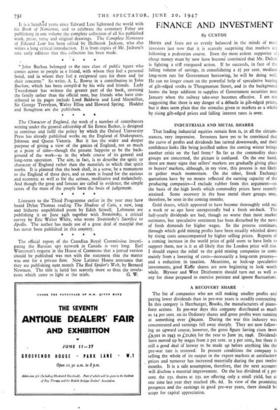FINANCE AND INVESTMENT
By CUSTOS HOPES and fears are so evenly balanced in the minds of most investors just now that it is scarcely surprising that markets are following a pedestrian course. Even the most ardent supporter off cheap money must by now have become convinced that Mr. Dalton is fighting a stiff rearguard action. If he succeeds, in face of the falling volume of savings, in consolidating a 21 per cent. medium long-term rate for Government borrowing, he will be doing well. He can no longer count on the powerful help of speculative buying of gilt-edged stocks in Throgmorton Street, and in the background looms the large addition to supplies of Government securities next January when the railway take-over becomes effective. I am not suggesting that there is any danger of a debacle in gilt-edged prices, but it does seem plain that the stimulus given to markets as a whole by rising gilt-edged prices and falling interest rates is over.
INDUSTRIALS AND METAL SHARES That leading industrial equities remain firm is, in all the circum- stances, very impressive. Investors have yet to be convinced that the curve of profits and dividends has turned downwards, and their confidence looks like being justified unless the coming winter brings another crisis on the fuel front.* So far as the commodity share groups are concerned, the picture is confused. On the one hand, there are many signs that sellers' markets are gradually giving place to buyers' markets, although, in my view, this process is not likely to gather much momentum. On the other, Stock Exchange quotations have by no means reflected the earning capacity of the producing companies—I exclude rubber from this argument—on the basis of the high levels which commodity prices have recently attained. Some recovery in the base metal share groups may, therefore, be seen in the coming months.
Gold shares, which appeared to have become thoroughly sold out a week or so ago have unexpectedly had a fresh set-back. The half-yearly dividends are bad, though no worse than most market estimates, but speculative sentiment has been disturbed by the news of fresh demands for higher wages. So the process continues, through which gold mining profits have been steadily whittled down by rising costs unaccompanied by higher selling prices. Reports of a coming increase in the world price of gold seem to have little to support them, nor is it at all likely that the London price will rise. I should expect the relief to the gold mining companies to come mainly from a lowering of costs—necessarily a long-term process— and a reduction in taxation. Meantime, as lock-up speculative investments, good Kaffir shares are now beginning to look worth while. Blyvoor and West Driefontein should turn out as well as any for those prepared to exercise patience and ignore fluctuations.
A RECOVERY SHARE
The list of companies who are still making smaller profits and paying lower dividends than in pre-war years is steadily contracting. In this category is Herrburger, Brooks, the manufacturers of piano- forte actions. In pre-war days this company distributed as much as 14 per cent. on its Ordinary shares ana gross profits were running at something over £6o,00o. During the war this industry was concentrated and earnings fell away sharply. They are now follow- ing an upward course, however, the gross figure having risen from £9,501 in 5943 to £21,605 for the year to June 3o, 5946. Dividends have moved up by stages from 2 per cent. to 5 per cent„ but there is still a good deal of leeway to be made up before anything like the pre-war rate is restored. In present conditions the company is selling the whole of its output in the export markets at satisfactory prices and turnover has increased materially during the past twelve months. It is a safe assumption, therefore, that the next accounts will disclose a material improvement. On the last dividend of 5 per cent. the iss. shates at 25s. are offering only a small yield, but at one time last year they reached 28s. 6d. In view of the promising prospects and the earnings in good pre-war years, there should be scope for capital appreciation.


































 Previous page
Previous page